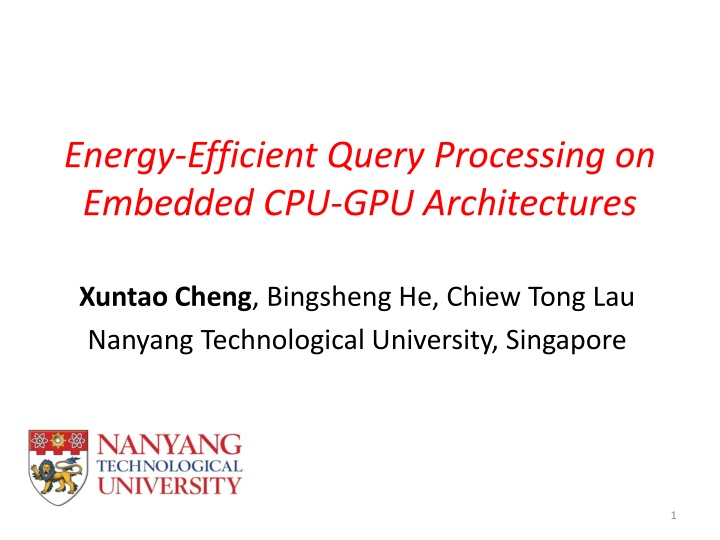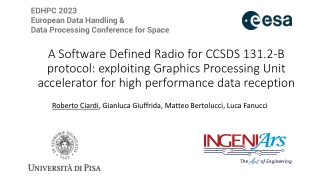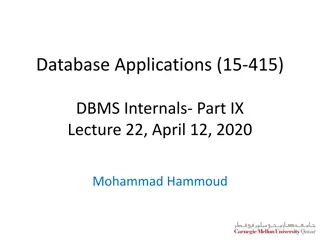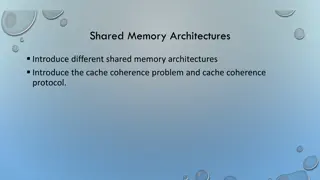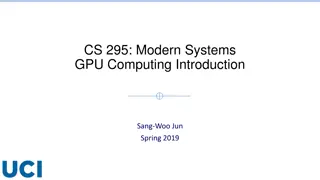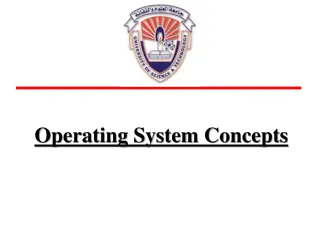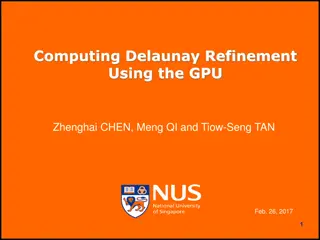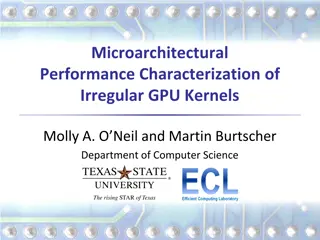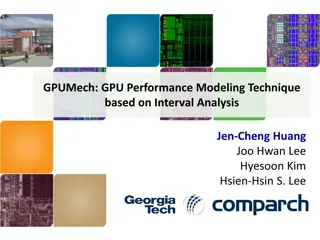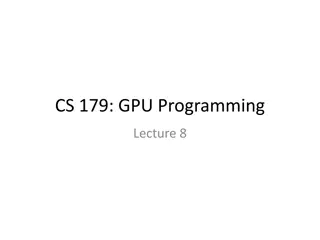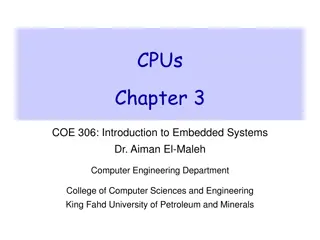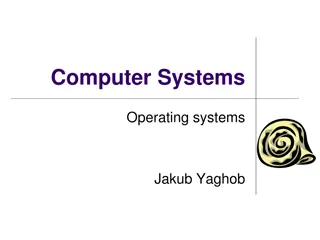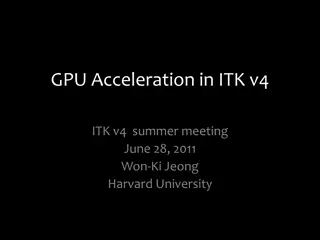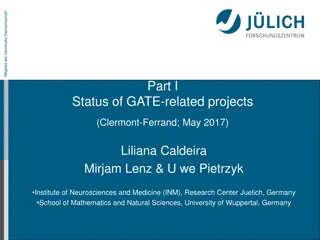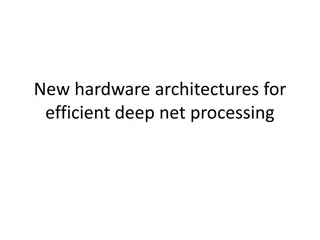Energy-Efficient Query Processing on Embedded CPU-GPU Architectures
This study explores the energy efficiency of query processing on embedded CPU-GPU architectures, focusing on the utilization of embedded GPUs and the potential for co-processing with CPUs. The research evaluates the performance and power consumption of different processing approaches, considering the emerging use of embedded GPUs in lightweight databases for IoT devices.
Download Presentation

Please find below an Image/Link to download the presentation.
The content on the website is provided AS IS for your information and personal use only. It may not be sold, licensed, or shared on other websites without obtaining consent from the author.If you encounter any issues during the download, it is possible that the publisher has removed the file from their server.
You are allowed to download the files provided on this website for personal or commercial use, subject to the condition that they are used lawfully. All files are the property of their respective owners.
The content on the website is provided AS IS for your information and personal use only. It may not be sold, licensed, or shared on other websites without obtaining consent from the author.
E N D
Presentation Transcript
Energy-Efficient Query Processing on Embedded CPU-GPU Architectures Xuntao Cheng, Bingsheng He, Chiew Tong Lau Nanyang Technological University, Singapore 1
Outline Motivations System Design Evaluations Conclusion 2
Query Processing in the Era of IoT IoT devices collect a lot of information and stores them in databases like SQLite, MySQL and SQL Server Express. These lightweight databases evaluate user queries from many mobile applications. Energy consumption of query processing is important on such battery-powered systems. 3
Embedded GPUs are Emerging Embedded GPUs have been incorporated in new-generation embedded devices. They offer higher performance for video/image processing than embedded CPUs. However, they have higher powers than embedded CPUs. 4
The Embedded CPU-GPU Architecture CARMA GPU Workstation CPU ARM Cortex-A9 (quad-core, 1.3GHz, ~ 9W) Intel Xeon E5-2650 (6-core, 2GHz, ~ 95W) GPU NVIDIA Quadro 1000M (96-core, ~ 45W) NVIDIA Tesla K40C (2880-core, ~ 245W) Memory 2GB 16GB Storage 4GB eMMC 256GB SSD PCI 4x PCIe Gen 1 (250MB/s) 16x PCIe Gen 3 (985MB/s) Idle power ~ 10W ~ 80W Peak power ~ 50W ~ 400W 5 The power of the embedded GPU is 5 times higher than its CPU counterpart. The power of CARMA is 8 times lower than a workstation.
Our Questions Is it more energy-efficient to use embedded GPUs for query processing? Challenge: the embedded GPU is more powerful, but it consumes more power. Can we further improve the energy efficiency by exploiting CPU-GPU co-processing on such embedded CPU-GPU architectures? Challenge: PCIe bus is slow. 6
Outline Motivations System Design Evaluations Conclusion 7
Methodology 1. Build a query processor on CARMA. 2. Consider three types of executions: CPU-only, GPU-only, and CPU-GPU co-processing. 3. Two complementary approaches Micro-benchmarks: individual query operators Macro-benchmarks: queries (e.g., TPC-H) 1- GPU core core core core GPU core core core core GPU GPU GPU GPU GPU GPU CPU core GPU core core core core GPU core core core core GPU GPU GPU GPU GPU GPU 8
Layered Design of the Query Engine Four common operators as micro- benchmarks. Scan and hash indexes require relatively fewer storage. CPU/GPU parallel algorithms are used for each primitive. Relations are stored in the column stores. Layered Design (adopted from GPUQP) 9
Implementations CPU We adopt codes from related work (VLDB 13) and our recent implementation on multi-core CPUs (VLDB 15). GPU We adopt codes from our previous work (TODS 09 and VLDB 13). We re-optimized each CUDA kernel for CARMA. CPU-GPU co-processing Inputs are partitioned and distributed between the CPU and the GPU according to . Final results are achieved by merging/concatenating partial results from both processors. 10
Experiences Some state-of-the-art libraries cannot be easily cross- compiled. We have to manually edit the architecture-specific codes and makefiles, and build them from scratch. Peripherals of CARMA are not stable. The Ethernet connection occasionally slows down dramatically. HDMI ports are almost broken. We lack technical means for fine-grained energy measurements. We cannot measure the power of CPU or the GPU separately. Power of the board is occasionally abnormal. 11
Outline Motivations System Design Evaluations Conclusion 12
Evaluation Setup Workloads Operators: selection, sum, sort and hash join Queries: TPC-H query 9 and 14 R and S relations 50M tuples each Two attributes in each tuple: (32-bit key, 32-bit record-ID) TPC-H query 9 and 14 Scale factor: 0.5 (size=500 MB) Metrics Execution time Energy consumption Watts up? PRO power meter 13
Evaluations: Selection & Sum Selection Sum The CPU-only approach delivers the best performance and the lowest energy consumption for selection and sum which are all memory intensive. 14
Evaluations: Sort & Hash Join Sort Hash join GPU becomes more competitive when the workload is more computation intensive. The fastest execution does not always guarantee the lowest energy consumption (e.g., when =0.5 in sort). 15
Evaluations: TPC-H Q9 and Q14 Q9 Q14 The GPU-only outperforms the CPU-only for selected analytical queries. The CPU-GPU co-processing achieves the best performance and the lowest energy consumption. 16
Comparison with a Workstation Partitioning of input relations are needed for CARMA when the size is larger than 5 million. CARMA is more energy efficient only when the workload size is small. 17
Outline Motivations System Design Evaluations Conclusions 18
Conclusions Embedded GPUs have become an integral component in embedded systems. Although the embedded GPU consumes more power, its higher computation capability and memory bandwidth are still beneficial for energy-efficient query processing. The embedded CPU is more energy-efficient when processing simple operators such as selection and sum. The embedded GPU outperforms the embedded CPU for computation-intensive operators such as sort and hash join as well as analytical queries. The CPU-GPU co-processing can further increase the energy efficiency of query processing on embedded devices. 19
Towards Energy-Proportional Wimpy- Node Cluster Network A single UDT connection through the Ethernet can only maintain a speed of 29.8 MB/s. With Ethernet Jumbo Frames enabled, this can be increased to 41.2 MB/s. By allocating two CPU cores to handle two connections in parallel, the bandwidth can be further increased to 83.4 MB/s. Storage Current results are achieved based on an eMMC storage. Replacing eMMCs with SSD disks, the energy efficiency of both the CPU-only and GPU-only approach can be increased by 7% and 25% for sort. 20
Acknowledgement We thank NVIDIA for the hardware donation. This work is supported by the following grants and institutions. The National Research Foundation, Prime Ministers Office, Singapore under its IDM Futures Funding Initiative and administered by the Interactive and Digital Media Programme Office (Grant No.: MDA/IDM/2012/8/8-2 VOL 01). A MoE AcRF Tier 2 grant (MOE2012-T2-2-067) in Singapore. 21
Q & A Thank you. Our research group: Xtra Computing Group http://pdcc.ntu.edu.sg/xtra/ 22
